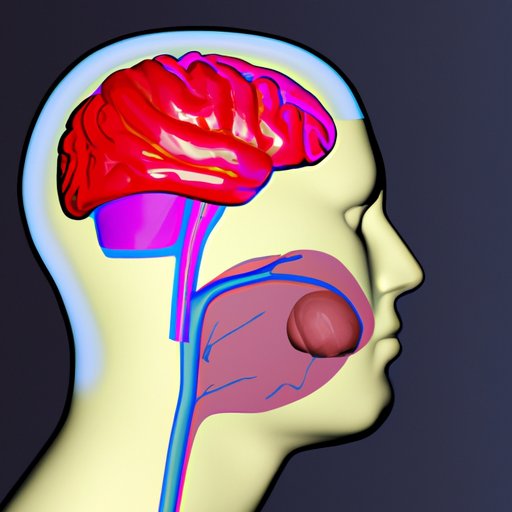Introduction
Breathing is a vital component of human life. It allows us to take in oxygen and expel carbon dioxide, and it keeps our bodies functioning properly. However, many people struggle with breathing issues, such as snoring, sleep apnea, or asthma, that can make it difficult to get the oxygen they need.
Understanding the Role of the Medulla Oblongata in Breathing: An In-Depth Analysis
The medulla oblongata is a part of the brainstem that is responsible for controlling several basic involuntary functions, including breathing. It is located in the lower part of the brainstem, just above the spinal cord. The medulla oblongata is connected to various parts of the body, including the heart, lungs, and diaphragm, via the autonomic nervous system.
The medulla’s primary role in respiration is to regulate the rhythm and depth of breathing. It does this by coordinating with the respiratory center of the brain, which is responsible for generating breathing patterns. The medulla also contains chemoreceptors that sense changes in blood gases, such as oxygen and carbon dioxide. These sensors trigger changes in breathing rates to ensure that oxygen levels in the body remain optimal.
Taking a Closer Look at the Respiratory Center of the Brain
The respiratory center is a group of neurons located in the medulla oblongata that are responsible for generating breathing patterns. It is divided into two parts: the ventral respiratory group (VRG) and the dorsal respiratory group (DRG).
The VRG is responsible for generating the basic rhythm of breathing. It contains neurons that fire in a regular pattern to generate the inhalation and exhalation phases of breathing. The DRG is responsible for adjusting breathing patterns in response to changes in blood gases and other factors, such as exercise or stress.
Discovering How the Brain Manages to Keep Us Breathing Without Us Even Knowing
Breathing is an automatic process controlled by the brain, meaning that we do not have to consciously think about it. The autonomic nervous system, which is responsible for controlling involuntary functions, regulates breathing rates based on the body’s oxygen needs. This system is also responsible for regulating heart rate, blood pressure, and other vital functions.
The interaction between the respiratory and cardiovascular systems is also important in regulating breathing. The lungs provide oxygen to the brain via the bloodstream, and the brain adjusts breathing patterns to maintain optimal oxygen levels. The cardiovascular system also helps maintain oxygen levels by delivering oxygen-rich blood to the body’s tissues and removing carbon dioxide.
The Science of Breathing: the Neurological Mechanisms that Keep Us Alive
The neurochemical basis of breathing involves several key neurotransmitters and hormones that play a role in regulating breathing patterns. For example, the neurotransmitter serotonin is involved in controlling breathing rates during sleep, appetite, and mood. The hormone progesterone is involved in regulating breathing patterns during pregnancy.
Changes in brain activity can also affect breathing, and vice versa. For example, when we are stressed, our breathing patterns may become shallow and rapid, reflecting the increased activity in the sympathetic nervous system.
Insights into the Brain: How it Coordinates with the Lungs to Facilitate Breathing
The relationship between the lungs and the brain is critical in maintaining optimal breathing patterns. The lungs provide oxygen to the bloodstream, which travels to the brain to meet its oxygen needs. The brain regulates breathing patterns to ensure that the body is receiving enough oxygen, and it adjusts its breathing rate based on oxygen needs.
The cardiovascular system also plays a crucial role in this relationship by facilitating the delivery of oxygen-rich blood to the tissues. During exercise or other high-demand activities, the respiratory and cardiovascular systems work together to meet the body’s oxygen needs.
Demystifying the Brain’s Control Over Our Breathing Patterns
Maintaining healthy breathing patterns is key to optimal respiratory health. There are several practical tips for promoting healthy breathing, such as deep breathing exercises, relaxation techniques, and maintaining good posture.
However, if you are struggling with breathing issues, it is essential to seek medical attention. Medical conditions such as sleep apnea or asthma can significantly impact respiratory health and require appropriate diagnosis and treatment.
Conclusion
The brain plays a crucial role in regulating breathing, from controlling the basic rhythm of breathing to adjusting breathing patterns in response to changes in the body’s oxygen needs. Understanding the neuroscience behind breathing can help promote respiratory health and wellness. By prioritizing awareness and education, we can work towards optimal respiratory health for all.
